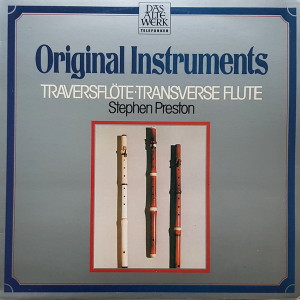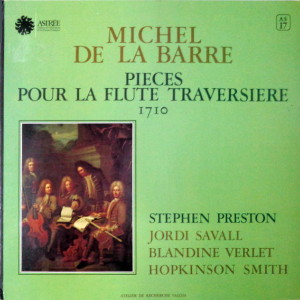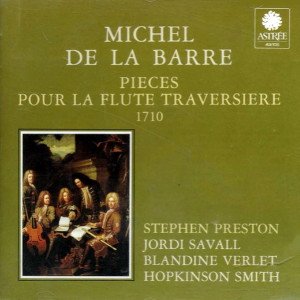 |
1 LP -
Telefunken 6.42325 AP (p) 1978
|
 |
| 1 LP -
Astrée AS 17 (p) 1978 |
 |
| 1 CD -
Astrée E 7786 (c) 1991 |
|
ORIGINALINSTRUMENTE -
Traverflöte
|
|
|
|
|
|
|
|
| Michel de la Barre
(um 1675-1743) |
Suite
Nr. 2 G-dur - aus Livre I |
|
16' 17" |
|
| Pièces
pour la flûte traversière, 1710 |
-
Prèlude |
2' 55" |
|
A1 |
|
-
Allemande. La Signora |
2' 21" |
|
A2 |
|
-
Gigue. La Cadette |
1' 00" |
|
A3 |
|
-
Sarabande. L'Ainée |
3' 55" |
|
A4 |
|
-
Allemande. La Landais |
1' 54" |
|
A5 |
|
-
Rondeau. Le Ninon |
1' 24" |
|
A6 |
|
-
Gavotte. La Therese; Double |
1' 38" |
|
A7 |
|
-
Rondeau. Le Étourdi |
2' 25" |
|
A8 |
|
-
Gigue. L'Ecossoise |
1' 45" |
|
A9 |
|
Suite
Nr. 5 d-moll - aus Livre I |
|
14' 35" |
|
|
-
Prelude |
3' 35" |
|
B1 |
|
-
Allemande. La Mariane |
3' 03" |
|
B2 |
|
-
Rondeau. L'Affligè |
2' 52" |
|
B3 |
|
-
Allemande. La Villequiere |
2' 59" |
|
B4 |
|
-
Gavotte. La Bagatelle |
0' 47" |
|
B5 |
|
-
Rondeau. Le Provençal |
1' 19" |
|
B6 |
|
Suite
Nr. 9 G-dur - aus Livre II |
|
9' 34" |
|
|
-
Sonate. L'inconnu · Vivement
· (Lentement) |
3' 50" |
|
B7 |
|
-
Chaconne |
5' 44" |
|
B8 |
|
|
|
|
|
| Stephen PRESTON,
Traverflöte (Andreas Glatt, Kopie
nach Hotteterre, Anfang 18. Jh.) |
Jordi Savall,
Viola da gamba (siebensaitig,
unbekannter französischer Erbauer,
Ende 17. Jh.) |
|
|
Blandine Verlet,
Cembalo (Pierre Bellot, 1729;
Muée de l'Archevêché, Chartres) |
|
|
Hopkinson Smith,
Theorbe (vierzehnchörig, Mathias
Durvie, nach Mateo Sellas, Venedig
1637) |
|
|
|
|
|
Luogo
e data di registrazione |
|
Saint-Lambert-des-Bois,
Yvelines (Francia) - aprile 1977 |
|
|
Registrazione:
live / studio |
|
studio |
|
|
Producer |
|
Michel
Bernstein
|
|
|
Recording
Supervision
|
|
Dr.
Thomas Gallia, Milan |
|
|
Edizione LP |
|
TELEFUNKEN
- 6.42325 AP - (1 LP - durata 40'
26") - (p) 1978 - Analogico |
|
|
Originale LP
|
|
ASTRÉE
- AS 17 - (1 LP - durata 40' 26")
- (p) 1978 - Analogico |
|
|
Prima Edizione CD |
|
ASTRÉE - E 7786 -
(1 CD - durata 40' 26") - (c)
1991 - AAD |
|
|
Note |
|
Produced
by Astrée |
|
|
|
|
The 17th
century brought
important changes
in the
construction and
mode of playing of
many musical
instruments, among
them the
transverse flute.
Throughout the
century the term
flute continued to
refer to the
recorder. But
probably after
1650 - the
beginnings are
obscure - work
began in Paris on
a new flute which
was intended to
have a greater
tonal range. In
place of what
until then had
been a cylindrical
tube, the
instrument was
given a conversely
conical bore; that
is to say, the
tube narrowed down
from the
embouchure to the
end; the
finger-holes were
designed according
to the reach of
the fingers. The
instruments were
made of box-tree,
ivory, maple,
peartree, ebony or
rosewood, and
until the
beginning of the
18th century
possessed a valve.
Jacques
Hotteterre, the
flute virtuoso and
instrument maker,
called “Le
Romain”, in his
fundamental work
on performance and
construction of
the instrument
“Principes de la,
flûte traversière”
(Paris, 1707) was
the first to
suggest an
arrangement of the
finger-holes based
upon the acoustic
principles of mean
tone tuning, the
.most important
precursor of
well-tempered
tuning.
Hotteterre’s
directions on
construction and
performance
disposed of the
problems existing
until then
resulting from
differing finger
reaches, and
construction of
the instrument was
then determined by
the finger reach.
Furthermore
Hotteterre’s
introduction made
it possible to
expand the tonal
range by higher
octaves. In view
of the fact that
it is based upon
the acoustic
principle of mean
tone intonation
and consequently
upon pure major
thirds, they are
not the same as
the enharmonic
tones on the
present-day piano:
according to
Hotteterre’s
system, the A
lowered to A-flat
sounds higher than
the G raised to
G-sharp. Nowadays,
instruments with
varying tone
rendering play the
G-sharp higher, as
a leading note to
A; As far as music
of that time was
concerned,
however, this
solution involved
adjustment to the
musical practice
of the singers and
violinists. An
instrument with
qualities of this
kind was played in
the present
recording. From a
language point of
view the
transverse flute
was distinguished
from the recorder,
generally
described as the
flute, by way of
the names flûte
traversière, flûte
d’Allemand or
simply Traversa.
Of the instruments
in various
registers, only
the descant
register was
really able to
hold its own,
while the others,
such as flûte
d’amour or
Traversa bassa
remained special
forms.
Initially the
instrument was
played only by
aristocratic
personages in
France; but due to
the predilection
of Frederick the
Great for the
instrument, it
became the most
widely distributed
music lover’s
instrument of the
18th century.
Johann Joachim
Quantz
(1690-1771), flute
tutor to the
mighty Prussian
monarch, reported
on his first
lessons in 1719 in
Dresden: “At that
time there were
not many pieces
written
specifically for
the flute. For the
greater part one
made do with oboe
and violin pieces
which each person
utilised as best
he could”. The
number of
concertos dating
back to the 18th
century, however,
has been estimated
at about 6,000.
With the “Pièces
pour la flûte
traversière” by
Michel de la Barre
(ca. 1675-1743)
the first works
for the instrument
appeared in print.
As flautist, de la
Barre performed as
a chamber musician
at the court of
the Sun King; as
composer, he
succeeded in
deriving typical
phrases from his
instrument. In
addition to two
operas, he wrote
compositions for
one and two
flutes, as well as
trios for flute,
violin and oboe.
Gerhard
Schuhmacher
(English
translation by
Frederick A.
Bishop)
|
|
|

